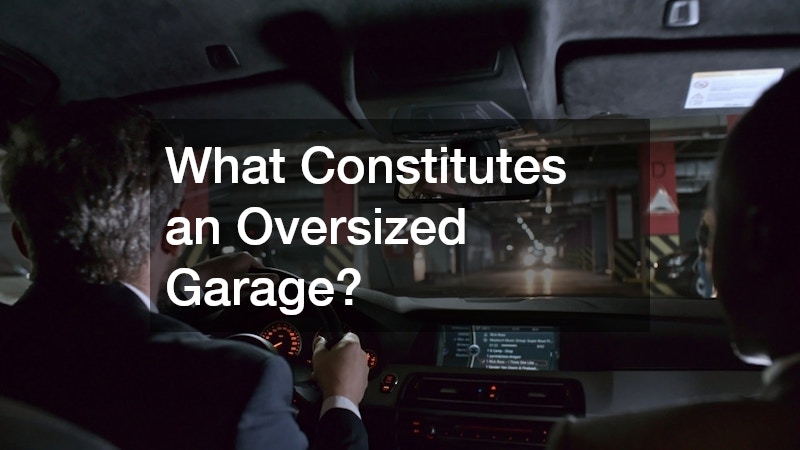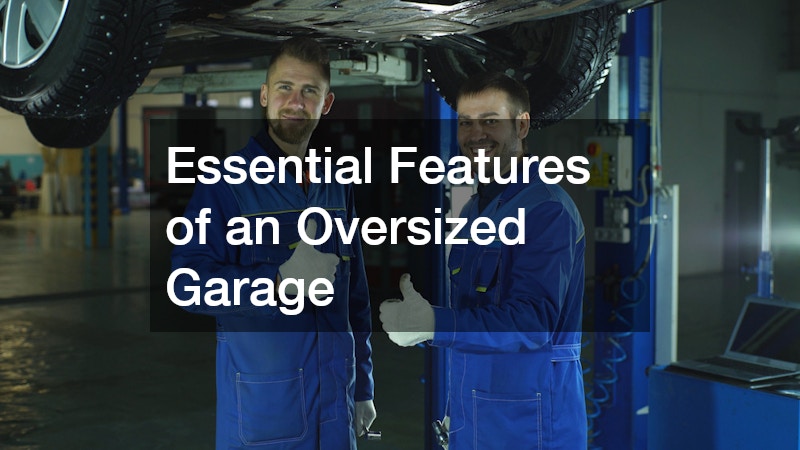Discover the essential elements that make an oversized garage a critical asset for auto shops and commercial operations, from enhanced space utilization to advanced design considerations. In today’s competitive automotive and service industries, the garage is more than just a shelter for vehicles—it’s a multifunctional hub where productivity, safety, and customer satisfaction intersect.
1. What Constitutes an Oversized Garage?

An oversized garage is defined by its expansive dimensions, typically larger than standard garages to accommodate more vehicles and equipment. These garages are designed to house multiple cars, such as in an auto repair garage, or large vehicles such as RVs. With retractable garage screens, they also offer versatility in modifying the space as per the day-to-day needs of the operation. The added space can include designated work zones, storage lofts, or even customer waiting areas for businesses that want to combine service efficiency with a better client experience.
The increased size is not only about width and length but also height, making it suitable for commercial garage doors that need to cater to larger vehicles. Oversized garages often come with enhanced structural integrity and flooring capable of bearing heavy loads. As the demand for big spaces grows, many garage builders are increasingly focusing on creating customized oversized garage solutions that can evolve alongside the business, ensuring that future expansions or changes in vehicle size don’t require costly structural alterations.
When defining what constitutes an oversized garage, it’s essential to consider both the needs for current operations and future expansion. Whether for auto shops or personal use, ensuring the space is adaptable to various needs can greatly enhance its utility. The inclusion of modern garage storage services often complements the design, maximizing space efficiency.
2. How Does an Oversized Garage Benefit Auto Shops?
Oversized garages greatly benefit auto shops by providing space that facilitates efficient workflow and storage solutions. The additional room allows for simultaneous repair of multiple vehicles, enhancing productivity. Auto repair garages equipped with oversized spaces can efficiently manage large maintenance tasks alongside routine repairs, avoiding bottlenecks that might occur in smaller facilities. This is especially valuable for businesses handling both consumer vehicles and commercial fleets.
The ability to store parts and tools within the garage saves time otherwise spent fetching supplies, promoting seamless operations. Many oversized garages come with customized garage door solutions, such as commercial garage doors, which support the movement of large equipment. This aids in creating a more organized and clutter-free working environment, essential for safety and efficiency. Well-placed storage also ensures quick access to frequently used tools, which can shave minutes off each job—time that adds up significantly in a high-volume shop.
Furthermore, oversized garages often feature advanced ventilation and lighting systems tailored to the needs of commercial operations. This ensures a comfortable working environment irrespective of the weather outside. Incorporating features such as new steel garage doors also contributes to improved security, safeguarding high-value equipment. Enhanced insulation can also regulate internal temperatures, reducing energy costs for heating or cooling.
3. Design Considerations for Oversized Garages
The design of an oversized garage should prioritize both functionality and safety, integrating elements that accommodate current and prospective needs. Critical design considerations include maximizing natural light, optimizing space usage with retractable garage screens, and ensuring optimal climate control. Architects and garage builders must consider the ease of vehicle movement within the garage, especially for larger vehicles like RVs. Drive-through designs or wide turning radii can reduce the risk of accidents and improve workflow.
Considering the durable materials for walls and flooring is essential to sustain the heavy-duty demands of an oversized garage. Garage door installation should be carefully planned to suit the size and number of entries, taking into account the physical and operational demands of the business. In auto repair garages, special flooring options can also be considered to withstand the wear and tear of moving vehicles and equipment. Epoxy-coated concrete, for example, can resist oil stains and chemical spills while providing a smooth surface for rolling tool carts.
Additionally, the aesthetics of an oversized garage should not be overlooked, as they contribute to the brand image of a commercial operation. Sleek designs with matching colors for doors, walls, and ceilings can create a cohesive look. Technological considerations, such as automated systems for ventilation and lighting, are integral to modern oversized garage design. Integrating smart controls allows for remote management, enabling business owners to adjust settings even when off-site.
4. Essential Features of an Oversized Garage

Robust access solutions are paramount, with commercial garage doors being an indispensable element. Doors not only need to be large and sturdy but also smooth in operation, often requiring the services of a proficient garage door repair company. Each bay’s commercial garage door should be specified for duty cycle, speed, and safety to match the workflow of the operation. Security features such as surveillance cameras and alarm systems are widely implemented to protect assets stored within these expansive spaces, giving both owners and customers peace of mind.
The installation of retractable garage screens provides versatility by transforming areas for alternate uses as needed, whether for vehicle maintenance or showcasing. Further, automatic systems for opening and closing these screens enhance convenience and operational speed. Modern oversized garages increasingly feature advanced climate control and ventilation systems, crucial for maintaining suitable working environments. Some even incorporate air filtration systems to remove harmful particulates from welding, painting, or mechanical work.
Included often are garage storage services, providing bespoke shelving and cabinetry to cater to the specific needs of each business. These storage solutions optimize space utilization, ensuring a tidy and efficient workspace. Moreover, state-of-the-art new steel garage doors enhance structural integrity and provide better resistance to weather elements, protecting valuable equipment from rust, corrosion, and temperature extremes. When wear or accidental impact occurs, scheduling timely garage door replacement keeps the building secure and minimizes downtime.
5. Cost Factors of Building an Oversized Garage
The cost of constructing an oversized garage can vary widely, influenced by factors such as size, material quality, and specific features included. High-grade commercial garage doors and advanced security systems contribute significantly to the overall expenditure. Engaging a reputable garage builder for quality craftsmanship can impact the initial investment but prove economical in the long term, as fewer repairs and replacements are required.
Material choices, particularly for the floor and structural components, can greatly affect costs. Durable flooring solutions are essential for high-traffic areas to prevent frequent repairs. While opting for new steel garage doors and other quality materials raises costs, they contribute to long-term savings by reducing the need for premature replacements. Energy-efficient materials, while more expensive initially, can also yield lower utility bills over time.
Customization also plays a significant role in determining expenses. Tailored design elements and specialized installations, such as indoor lifting systems or retractable garage screens, can increase costs. However, these expenses can be offset by the increased efficiency and operational ease gained through a well-planned investment. It’s wise to include a line item for future garage door replacement as part of a lifecycle maintenance plan so budgets remain predictable and operations uninterrupted.
6. Customization Options for Different Operational Needs
Customization of an oversized garage is key to maximizing its utility in meeting specific operational requirements. Many auto repair garages require specialized floor coatings and drainage systems to manage spills efficiently. Garage door installation can also be customized, with options for automated systems that suit particular business flows, such as high-speed roll-up doors for frequent access points.
The demand for tailored storage solutions has led many oversized garages to incorporate customized cabinetry and partitioning, meeting unique organizational needs. Technological integrations, such as automated lighting and HVAC systems, enhance operational efficiency, ensuring the garage remains functional and comfortable year-round. Retractable garage screens offer flexibility, adapting spaces for distinct uses as needed—such as converting part of the garage into a seasonal customer lounge or display area.
Different businesses may opt for different degrees of insulation, driven by climate or cost considerations. Customizing ventilation systems and choosing low-maintenance materials can also align the oversized garage with sustainability goals. Ultimately, the ability to customize enables garages to accommodate a wide range of vehicles, from small cars to large RVs, as well as different types of commercial work.
7. Maintenance and Lifecycle Planning for Oversized Garages

Proactive maintenance preserves safety, uptime, and long-term value. Establish a service schedule with a trusted garage door repair company to inspect springs, cables, sensors, and operators at regular intervals. Keep common wear parts on hand to shorten repair times, and document all work to maintain warranty coverage on equipment and finishes.
Plan for periodic upgrades as codes, technology, and business needs evolve. If an operator’s duty cycle is exceeded or a panel is compromised, prompt garage door replacement reduces liability and prevents workflow disruptions. When replacing doors, consider new steel garage doors with improved insulation and wind ratings, and coordinate the garage door installation during off-peak hours to minimize impact on throughput.
Lifecycle planning should also account for finish renewal (such as recoating epoxy floors), lighting retrofits, and controls modernization. Treat each bay’s commercial garage door as a critical asset with its own maintenance log, service intervals, and budget allocation.
8. What Safety Considerations Should Be Taken Into Account?
Safety is a critical aspect of any oversized garage. Ensuring compliance with local building codes and safety regulations is essential during the design and construction phases. Incorporating advanced fire suppression systems and emergency exits enhances safety, creating a secure environment for both workers and vehicles. In high-traffic garages, marked pedestrian zones can prevent collisions between staff and moving vehicles.
Well-configured lighting solutions reduce accidents, ensuring visibility in crucial areas. Automated garage door systems prevent injuries by incorporating safety sensors that stop doors from closing on obstructions. Additionally, regular maintenance by a garage door repair company is recommended to keep all components in safe and working order, reducing the risk of unexpected malfunctions during busy periods.
Significant emphasis should also be placed on secure storage facilities for hazardous materials, common in auto repair garages. Well-marked traffic flow pathways are vital for safe vehicle movement within the garage. Proper training and safety protocols should be in place, ensuring that workers are well-versed in operating the oversized garage systems safely. Regular safety drills can also keep staff prepared for emergencies.
9. Environmental Impact and Sustainability of Oversized Garages
Sustainability is increasingly integral in the design of oversized garages, with many features aimed at minimizing environmental impact. The use of recycled and sustainable building materials can significantly lower the ecological footprint of construction. Incorporating energy-efficient lighting and climate control systems reduces operational energy consumption, benefiting both the environment and the business’s bottom line.
Advanced insulation techniques and the installation of energy-efficient doors can substantially decrease energy demands. Solar panels offer an additional option for generating clean energy, contributing to reduced utility expenses and environmental impact. Water recycling systems for garages that frequently wash vehicles represent another sustainable practice, turning what was once waste into a valuable resource.
10. Examples of Successful Oversized Garages in Use

Many businesses have successfully leveraged oversized garages to streamline operations and improve their service offerings. For instance, large auto repair garages often feature expansive spaces that accommodate numerous vehicles simultaneously, enhancing service speed and quality. These garages integrate retractable garage screens that allow for flexible use of space, adapting to different vehicle repair tasks or seasonal demands.
A prominent RV garage company designed an oversized garage to provide complete service, including basic maintenance and intricate repairs, all in-house. This service expansion was made possible by incorporating custom storage and state-of-the-art equipment. The company also installed commercial garage doors wide enough to allow easy access for larger vehicles, making it possible to handle everything from compact cars to motorhomes.
The future of oversized garage design is leaning towards greater technological integration and smarter designs. Automated systems for climate control, lighting, and garage door operations are becoming more sophisticated, offering enhanced convenience. Adaptability will be a focus, with new retractable garage screen systems providing versatile space management solutions that cater to fluctuating business needs. Sustainability will continue to be a driving force, with increased use of eco-friendly and recycled materials. Future garages are likely to see the introduction of smart technology for security, energy management, and operational efficiency. These advances are designed to meet the growing demand for environmentally responsible and cost-effective solutions in the automotive industry. Whether the goal is to improve workflow in an auto repair garage, expand capabilities for an RV garage, or enhance customer experience with innovative features like retractable garage screens, investing in a thoughtfully designed oversized garage can deliver substantial long-term returns.


